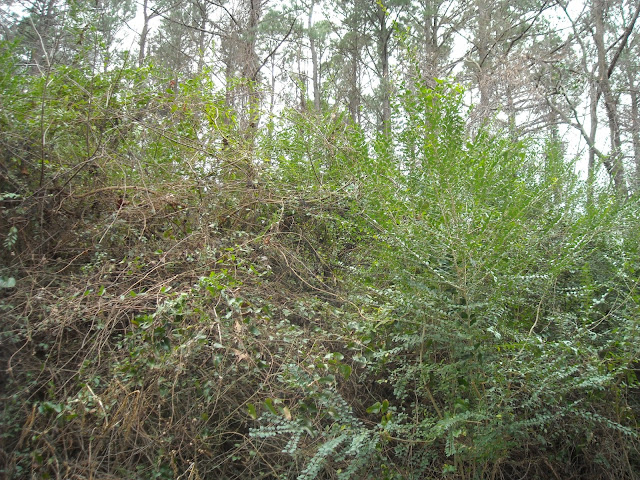In a
previous blog post, I mentioned that I was starting a natural resource management project at a local wildlife preserve.
Natural resource management involves the deliberate manipulation of natural ecosystems in order to enhance it's ecological function. On of the most common activities of natural resource managers today is that of
invasive species management. My project falls within this category, and as you can see from Photos A and B, European privet (
Ligustrum vulgare L.) can quickly dominate the understory of a wooded area eliminating valuable food resources that a diverse array of native plants could provide.
 |
Photo A: A monoculture of privet chokes out the understory of a forest near the trail center at the Hoffler Creek Wildlife Preserve in Portsmouth, VA. January 6, 2012.
|
 |
| Photo B: Large privet bushes. Same location as Photo A. |
Originally, I had intended to create three test plots, in which I would perform different control methods (see my
previous blog post, titled "It's a privet thing, okay?"). Yesterday (January 6), I decided to do a second 3X3' plot using the herbicide 'Rodeo', a glyphosphate-based solution. I was not satisfied with my first plot which I completed in September, in part because of its small size and also because it rained the next day, potentially washing away the chemical from the plant stumps (and possibly into the nearby lake!). Photo C shows what my second herbicide test plot looked like after I finished cutting and spraying all of the privet bushes within that plot.
 |
| Photo C: My second herbicide-treated privet test plot. |
As you may be able to tell, there was not much growing underneath the privet shrubs, except for a few redceder sprouts (
Juniperis virginiana), a weedy but native evergreen shrub. There was also a few small vines of Japanese honeysucke (
Lonicera japonica) which is another invasive plant, as well as some dead tree saplings. One can now can a better sense of the problems that exotic invasive vegetation brings to a natural landscape.
Rather than doing my control plot and my vinegar/baking soda solution plot that I was originally intending to do, I am instead just going to wait and see what happens with my two herbicide-treated plots. If this method ends up being effective, I see no reason to waste time experimenting with the other proposed methods.
Keep checking back to hear updates on this project!






Comments
Post a Comment